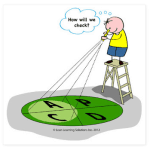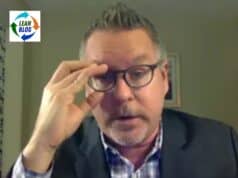Here's a great post from Pascal Dennis on Lean and PDCA (or PDSA):
PDCA – the Pounding Heart Muscle of Life
Everybody should read Pascal's post… twice. Honestly, go read it a few times before returning here.
I was fortunate to take an LEI class with him about five years ago. I've learned a lot from Pascal's books.
I was also very fortunate to work with him a bit in person…and I learned so much about problem solving from Pascal and his former Toyota colleagues.
Pascal is what I call “the real deal,” in that he worked for Toyota (in Canada) for many years. Pascal doesn't make Lean (the Toyota Production System) into some sort of complicated, mythical beast with lots of jargon… he humbly teaches people how to solve problems and how to improve.
A big part of solving problems is learning how to properly DEFINE problems. I am grateful to Pascal and his firm for what I learned and what was reinforced by them… asking, as John Shook (also from Toyota) recently reminded us, “what is the problem we are trying to solve?” Also, how do we really know it is a problem? What is the gap between “what should be happening” and “what's really happening?”
It takes discipline and humility to really study a problem instead of jumping to conclusions or jumping to solutions. It takes humility to “go and see” and actually talk to the people doing the work instead of assuming you know the answers because of your job title and leadership position.
As Pascal writes about, I've also heard people pish-posh at Lean and PDCA (or PDSA) as being too simple. I've found that the people who are newest to Lean are the ones who are most certain they understand everything. I've been studying and practicing Lean for 20 years… and as Pascal's sensei said, I feel like I'm barely understanding it… and that's why I find this a fascinating field to hopefully continue to study and practice for another 20 years or more.
Those who are new to Lean… they might have read one book or taken one class (or received one “belt” through a Lean Sigma program)… these are the folks who think Lean is just a bunch of neat tricks and techniques. I try to be patient and empathetic because I was like that once too.
We are taught a tool… we want to implement the tool. We're sometimes oblivious that the people in the workplace are annoyed with us for pushing tools on them or changing things without their input. As engineer, I was taught to have “the answer” instead of being comfortable in the murky fog of a change process…
Then, we learn how to teach the tool… understanding what problems need solved and how to engage others in the process. You're teaching it and inspiring change instead of doing it yourself.
Then, perhaps, we learn to teach others how to teach the philosophies and mindsets behind the tool.
Is this a natural progression or can people jump right to understanding principles, mindsets, and philosophies? I've tried teaching, through my books and articles, this blog, and tweets (and classes and speeches) that Lean is really about a mindset and a philosophy… that it's about Respect for People at its core. Yet, not everybody understands that. We see lots of “L.A.M.E.” and, thankfully, some “Real Lean” as Bob Emiliani calls it.
There are organizations out there, like ThedaCare, doing this right. There are other organizations that drive people to send me emails complaining (rightfully so) that the so-called “Lean” efforts are leading to layoffs, are forcing changes on people, or are hurting patient care. None of that is really Lean… but people call it that.
As David Mann said once, “It's not that Lean is complicated… it's very different.” Can we help folks understand or do they have to learn through their own mistakes?
Image copyright Lean Pathways
Please scroll down (or click) to post a comment. Connect with me on LinkedIn.
Let’s build a culture of continuous improvement and psychological safety—together. If you're a leader aiming for lasting change (not just more projects), I help organizations:
- Engage people at all levels in sustainable improvement
- Shift from fear of mistakes to learning from them
- Apply Lean thinking in practical, people-centered ways
Interested in coaching or a keynote talk? Let’s talk.
Join me for a Lean Healthcare Accelerator Trip to Japan! Learn More











Besides those who are new having an oversimplified view those that don’t understand the importance of continual learning and experimentation fail to appreciate how deeply the impact of lean should be felt.
It is hard to grasp at first how interrelated everything is. Respect for people isn’t one simple thing. It permeates everything. Failures in that domain leak into everything else and cripple the ability of other concepts/tools… to work as they should.
Unfortunately I think that for the most part people need to learn through their own mistakes. Most of the time that is the only way that humility can take place. There is a big difference between information and wisdom. One is given. One is earned.
We can’t blame individuals for what they don’t know. That’s why I try to be patient and understanding with folks who are new to Lean.
We can, perhaps, blame teachers, professors, authors, consultants who teach a limited view of Lean (those who teach “Lean is just 5S and some tools from a toolbox”) or those who teach things that are incorrect (such as “Lean is just about speed and efficiency”).
Can we blame the teacher for not inspiring people to want to go and read more, including the books by Ohno, Shingo, and modern books by people directly from the company, like “Toyota by Toyota”?
When it comes to professors, it is a process problem not a people problem. The hiring process – then and now – strongly favors candidates with 100% academic experience and 0% practical work experience. As a result, many professors don’t know about Lean or are unable to do more than teach a limited view of Lean or even incorrect things about Lean.
As far as inspiring people to read more, you’d be surprised how few students have a strong enough interest in Lean to do that no matter how inspirational the teacher is.
Good point, see my experience with this professor spouting things about Toyota that are completely untrue:
Link from last year
Your comment makes me think of Dr. Deming… who would say we can’t motivate somebody, we can only hope to not demotivate them.
Another perspective. We live in the age of the quick fix. The overnight success. The immediate return. The short-term. Maybe not all of us but certainly a great many.
So when more is required – the effort and willingness to see, time and patience to observe and reflect, critical thinking to assess and evaluate, persistence to experiment and test (I could go on) – is it any wonder that we go grab the tool and just do it? Is it any surprise then, that any resultant improvement attained in this fashion will also not sustain in the long run?
No, Lean is not complicated. But like anything else that delivers sustainable value and worth over time, it’s very, very hard to do well.
I don’t think there’s an easier way. We’ll all have to learn from our own mistakes.
Great point, Adam. Lean isn’t complicated, but it’s certainly not a “quick fix.”
Great post, Mark. And great comments from the readers. This is such a big subject, and there are so many ways to go. I agree with the simple approach – see a problem and solve it, then another and another. Work to build a culture. Involve everyone. Make things better. Yes, learn and use the tools, but keep it as simple as possible.
Mark,
I enjoy your work (blog, books, podcasts) and following your connections to other lean thinkers. I am new to Lean. My organization’s Lean journey began in 2005 and I jumped on board as a project leader in 2009. Having experienced our internal Lean Six Sigma development program, I get a chuckle from comments reminding me of the mash up my org created 9 years ago. However, I do believe that we employ Lean (or LSS) generally well as an organization. It is not how we operate….yet.
Admittedly, we do fall into the BDP trap at times. Meaning, take what that distribution does well and standardize across the network. I think we sometimes miss the point. Maybe we’ve identified an ideal state but we still have to let the on site teams go through the improvement process (PDCA) themselves to feel the pain and then the results of improvements.
Thanks, Paul. What do you mean by BDP?
I think large organizations often find a “better practice” (it’s never a “best practice” or a “perfect practice”)… but a practice often gets treated as “ideal” and it’s forced on others (other departments, other sites, etc.).
The other areas might be different enough where that better practice doesn’t apply. Or, they might not have the same problem to solve.
You’re right, that giving a solution to others might shortchange their own learning.
I like what ThedaCare does… they develop a new practice in Area A. Then, they share it with Area B and ask them to use that as a starting point… and modify it or make it better as appropriate. Then, if it’s made better yet, it’s shared back with Area A.
That’s more of a PDSA approach – continual improvement – instead of “rolling out” *the* best answer.
Mark,
‘Best Demonstrated Practice’ I think the ThedaCare approach you describe is an effective way to execute “BDP Sharing”, as we call it. I also see elements where we’ve done it that way but senior leaders / middle management remain that wants the quick fix outcome. We’re on the right path, just need to understand the nuance of BDP sharing versus BDP implementing more clearly throughout the org.
Thanks. And that’s where senior leaders and their behaviors often interfere with Lean becoming “the way we do things” in both practices and mindsets. If senior leaders can’t prioritize the long term over the short-term, this all fails. If they think Lean is simple and can therefore be “implemented” in 180 days, then this fails. If they jump to solutions, blame others, and steamroll others… this doesn’t work.
Great post Mark and I agree that oversimplification happens often with Lean. I wonder how often Lean is an appropriate solution for any given situation. Organizations are made of people and relationships and some organizations just may not be a good cultural for for lean and would take too much “change” for them to make it worth their time. Hence the many examples of “L.A.M.E.” that we see.
Organizations or individuals. I can be very patient with somebody who says, “I’ve learned a little and now I’m going to humbly go try and improve things… and learn from the mistakes I’ll make along the way” — I try to have that be my attitude, not one of “expert” or such.
People who say, “I know a little bit, this stuff is easy, and I’m awesome, so I’m guaranteed to succeed” — those are the folks I try to avoid spending time with.
Agreed, sometimes there is an overconfidence in what the perception of Lean is.
“Is this a natural progression or can people jump right to understanding principles, mindsets, and philosophies?”
I think it’s possible, but probably not common. Personally, my first exposure to anything remotely related to Lean was reading “The Toyota Way” which is extremely light on tools and extremely heavy on principles, mindsets, and philosophies. It wasn’t until a good while later that I actually had an opportunity to practice any lean tools (beginning with goold old 5S and value stream mapping like many folks).
Starting with philosophy, instead of tools, was hugely advantageous for me. Even though I didn’t fully understand the principles at the time (I still don’t), I at least knew that Lean wasn’t all about or even mostly about tools. This conceptual foundation later allowed me to see lean tools as simply countermeasures to specific problems.
Many of our colleagues don’t begin their learning in this way. They are heavily exposed to tools first, or maybe they are exposed to philosophy but don’t really “get” it until they’re much farther along on their lean journey. Sometimes it just never clicks (no jokes about your Lean Sigma Double Black Belt buddies, Mark).
For the large number of people that need to practice lean tools first before messing with philosophy, a good strategy might be to make PDSA the primary tool. As Pascal Dennis explained in his blog post, it’s “the pounding heart muscle of life.” It’s what propels the insight and reflection needed for learning, which is what’s needed to understand lean principles.
Or at least that’s what I’ve observed in my practice of Lean in hospitals. The learning continues.
A number of years ago in a class on policy deployment (hoshin kanri) Pascal told us “At Toyota a manager’s job is to practice and teach PDCA”. This insight began the elevation of my understanding of lean from shop-floor changes to thinking that applied at any level. Lacking mentors in my relatively new role in general management, it became my guide: I finally knew what my job was! (the rest of the class helped, too!)
It is simple statement but deep, worthy of ongoing practice and exploration. A “40 year art”, indeed.
Early on in my Lean journey, I was in a large capability building class at my corporation, where Pascal was teaching about Problem Solving. He stated that, organizationally, we were significantly lacking in this skill.
I raised my hand and said something to the effect that, while we might struggle with problem solving across zones, we were pretty good at solving problems within our zone.
Pascal pointed his finger at me and, quite passionately said, “You are wrong. I’ve yet to see evidence that this organization is effective at solving problems to root cause.”
I felt pretty small, but, of course, over time we learned that he was 100% correct in that assessment. We just didn’t know it yet. :-)
“Is this a natural progression or can people jump right to understanding principles, mindsets, and philosophies?”
My experience is that no one ever “gets it” without lots of DOING under the guidance of an experienced sensei.
Most people don’t deal well with ambiguity. They’ll fill in whatever mental gaps they have rather than deal with the anguish of not “getting” something.
A good sensei will constantly bring them out of this comfort zone. “Oh, you get it? That’s great! Will you please explain to me how. . .”
My experience is that people who just want to be “told the answer” are the ones who will never get the thinking. People who are willing to try, fail, try again, fail, try, almost get it, try, get it, try, learn how to do it better, etc. – are the ones who will eventually get the thinking.
Comments are closed.